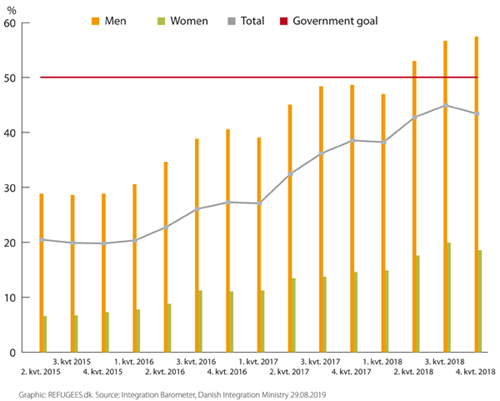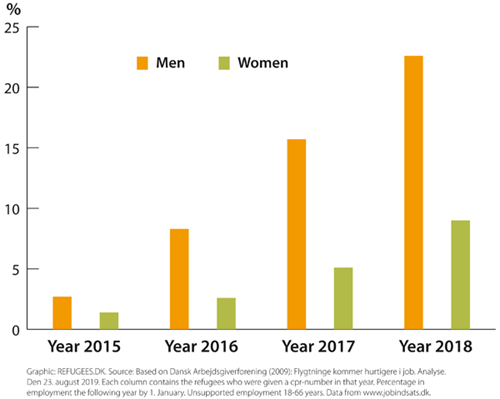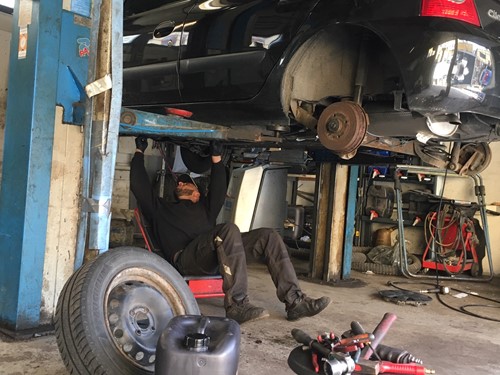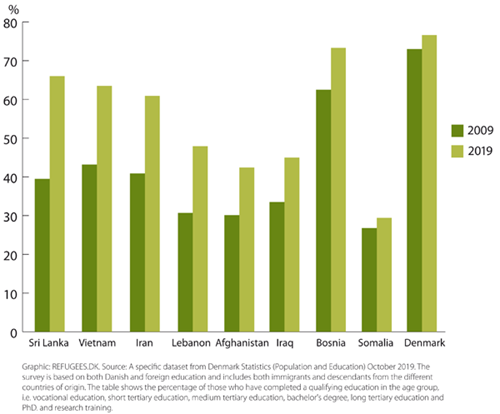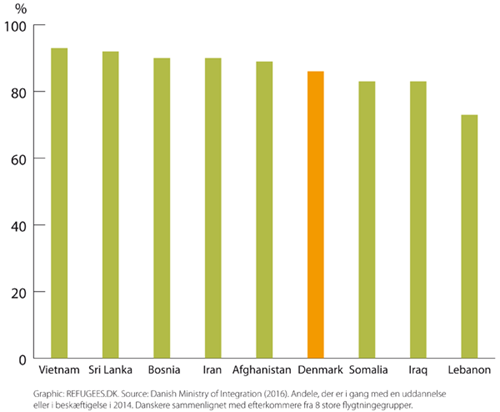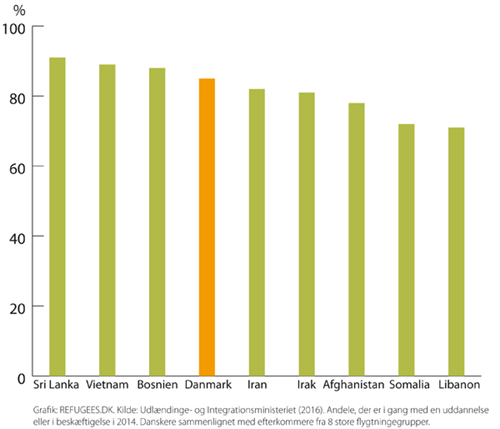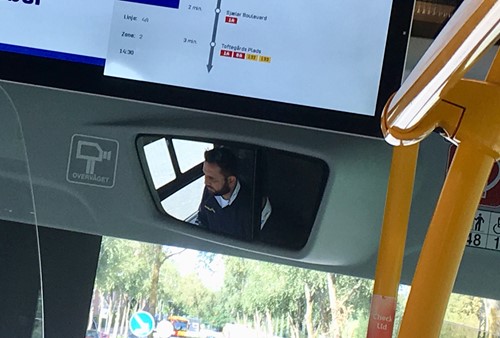How is it going with integration in Denmark?
Refugees and their children are in fact doing well in Denmark – migration researcher Hans Lassen has collected the most important facts
Hans Lassen is one of Denmark's leading experts on migration, read more on his web page sisyfos.or
Employment is a prerequisite for successful integration. Imagine that refugees did not contribute at all to the Danish labour market. Two things would happen: xenophobia would increase dramatically to double what we have experienced to date; and there would be an increasing tendency towards extremism and fundamentalism in the immigrant communities.
Therefore, the first question to answer when asking how integration is going is: what is the employment situation like for refugees?
Employment
It is well documented that refugees have a lower employment rate than both Danes and other non-Western immigrants. One very important reason for this is that the refugee groups are significantly more burdened by trauma that constitutes a barrier to the labour market. It is estimated that somewhere between 30 and 50% of all refugees have trauma.
However, Figure 1 shows that in recent years there has been a marked increase in the employment and family reunion of refugees. In the period from 2015 to 2018, the employment rate of refugees with more than three years of residence more than doubled, from 20 to 43%. This is a significant growth of 23 percentage points in just three years.
Figure 1: 21-64 year-old refugees and family reunified to refugees employed after 3 years in Denmark
With an overall employment rate of 43%, we are approaching the previous government's success criterion - that at least half of all refugees should be in employment after three years of residence. This success criterion has been surpassed by male refugees who have an employment rate of 57%. On the other hand, this is not the case for female refugees, with only 19% entering the job market.
In addition, there is a very clear tendency for refugees to get jobs much faster, as shown in Figure 2.
Figure 2: Refugees find jobs faster
The graph shows how employment has evolved for each year that refugees were granted asylum from 2015 to 2018. It provides an answer to the following questions: how many are in jobs the year after they were granted asylum? As you can see, there were approx. 3% of male refugees in work from 2015. For those granted asylum in 2018, the share had grown to approx. 23%. There has also been an increase for female refugees, but again at a much lower level, from 1.4 to 9.0%.
Refugees have the same level of motivation to find work as Danes. This has been demonstrated in various attitudinal studies (see for example Jørgen Goul Andersen (2008)) where a large part of the respondents came from the largest refugee groups (Iran, Iraq, Lebanon, Somalia, Sri Lanka and Vietnam). Similar findings were concluded in a recent extensive qualitative study, conducted by the Greenhouse Research Centre (2019), where the respondents were exclusively Somali women. When the refugee groups as a whole - and this applies especially to women - have a lower employment rate than Danes and other non-western immigrant groups, this is not due to a lack of job motivation. Instead, possible explanations are a complex interaction between traumatic stress and poor educational and linguistic skills, lack of networks, poor labour market experience and cultural traditions.
Networks are a significant part of integration. They provide an introduction to important areas of Danish society. They also offer the opportunity to learn about Danish norms and to practice the Danish language. Over time, an increasing number of refugees have passed the Danish language test within five years, and in 2018 the figure was up to 67%.
In addition, networks have a more direct impact on employment. They can help with writing a CV or finding an internship in a company. And often they can be the reason why a refugee gets a job. Thus, about half of all new employee jobs in the Danish labour market are found via networks, cf. Statistics Denmark (2010).
The reasons for progress in relation to employment
Economic boom
We are now experiencing a very strong growth in the employment of refugees, comparable to the boom we experienced in the '00s. At that time, the employment rate among Somali immigrants, for example, increased by approx. 25 percent, from 13 to 38%, in the period 2001 to 2008, cf. Ministry of Refugees, Immigrants and Integration (2010). In addition, refugees also found jobs faster in the ‘00s. Both today and at that time, it is refugee groups that experience the strongest increase in employment in the Danish labour market.
Thus, there is a historical pattern in which a boom in the economy is associated with a particularly high rise in refugee employment. But it is important to emphasize that such an increase, regardless of the economic downturn or not, has only been possible because companies have been - and are still - very satisfied with refugees as a labour force. This is demonstrated by recent research showing that over 80% of companies have good experience with employees from refugee backgrounds.
Integration-based education (IGU), job centres and companies
Economic booms are not the only condition affecting refugees entering employment. There are many indications that the tripartite negotiations between the social partners in 2016 have strengthened municipal integration efforts in several ways. With the new integration education (IGU), refugees have gained a new stepping stone into the labour market which has been met with widespread satisfaction from both companies and municipalities.
The majority of refugees are now considered to be ready for a job, whereas in the past it was only a minority. In addition, they have entered organisations’ workforces faster, even if their Danish language skills are limited. The municipalities have expanded their cooperation with companies, for example through the increased use of industry packages and business centres. At the same time, several municipalities have used company-based Danish language teaching.

Lower benefits
The low integration benefits, the upper limit on financial assistance and the 225-hour rule have in the meantime had a limited effect. The Treasury estimates that, in isolation, the upper limit on financial assistance and the 225-hour rule have only increased employment by 250 full-time jobs. No studies on the impact of integration benefits have been published, but the Ministry of Employment has estimated that it is expected to help the placement of 400 more people in jobs. It could be considered as having a very limited effect when compared with the fact that from 2013 to 2018 approx. 48,000 more full-time employees with a non-Western background entered the labour market.
The Rockwool Foundation Research Unit has published a very compelling study (link in English) of the start-up aid introduced in the '00s, which is very similar to integration benefits. The results show that there is a short-term employment effect that disappears over time. The same analysis shows a large number of indirect and negative effects on employment: women becoming more excluded from the workforce, increased crime, less children attend crèche and kindergarten and perform poorly in the national tests in Danish. Finally, it shows that children who grow up in poverty have a lower income as adults. Just one year of poverty at the start of the very sensitive teenage years brings about a reduction in income (link in English) as an adult of approx. 12%
The Danish Institute for Human Rights’ report on families on integration benefits (link in English) from October 2018, paints a picture of deep poverty and deprivation, and the Danish Refugee Council in a statement from May 2019 warned against the negative consequences of low benefits on refugees.
We lack in-depth analysis of the counterproductive effects on employment that follow in the wake of better economic incentives. The above studies indicate that they exist. But what happens to the many adult refugees who receive low benefits without finding work? Are they moving further away from the labour market? If this happens, it will also have a potentially significant counterproductive effect on employment. Given how modest the positive effects are in increasing the financial incentives, only a few counterproductive effects are needed to make the overall impact become zero or even negative.
Human capital
In contrast to low benefits, human capital has been of great importance for the increase in employment. Human capital means education, Danish language skills and knowledge of the Danish labour market. The most important of these factors is education, which is elaborated on in the next section.

Education
Trauma increases the risk of lack of concentration and focus, which is crucial when learning a new language and taking education in the country you have come to. Together with the fact that for the most part refugees have a low level of education from their home country, this is one of the decisive reasons why refugees who live in Denmark are generally more poorly educated than Danes. Thus, 50% of all persons with asylum as residency have only completed education to a primary level. This is a significantly larger proportion than the Danes, with the corresponding figure being 19 and 16% respectively for men and women.
But at the same time, it is worth noting that the level of education among refugees and their children has been significantly raised. This is shown in Figure 3, where you can see the development in the proportion of 25 to 39 year-olds who have a qualifying education in the period from 2009 to 2019. It shows a significant growth. For example, Sri Lankan immigrants and descendants have increased their share by 26.5 per cent from 39.5 to 66 per cent. In contrast, another of the groups - immigrants and descendants from Somalia - have experienced only a modest growth of 2.6 per cent, from 26.8 to 29.4 per cent.
Figure 3. 25-39 year-olds with educational qualifications
The fact that there has been a significant increase in the level of education among the large refugee groups is of great consequence, because the well-known driving force in the labour market - that education provides jobs - also applies to refugees and family members reunited with refugees. When they graduate in Denmark, they achieve both better employment and higher wages in the long run than those who do not.
As Figure 3 shows for the period 2009 to 2019, Bosnians have almost caught up with the Danes. This group of refugees and descendants of refugees has already outperformed Danes in some educational parameters. Thus, in 2013, 71% of those in the 20-24 age group had at least completed their Danish education to a secondary education level. The corresponding figure for the Danes was “only” 69%. And this lead over the Danes is seen with both men and women.
Newly arrived refugees find it difficult to enter Danish education. Firstly they lack the entrance exam and therefore first need to spend time taking a 10th grade class and / or a full secondary-level education. And often it is very difficult to get the Danish authorities to recognise the educational qualifications they have from their home country.
Municipalities must encourage and inform about education if a refugee is between the ages of 18 and 25. But for those over 25, the main focus is on getting jobs quickly. Only having a full-time job is a relevant condition to be granted permanent residence, not education.
Employment and education
The tendency for some refugee groups to perform better than Danes can also be observed when focusing on how many of the young descendants from some of the largest refugee groups are either in employment or education, cf. Figures 4 and 5.
Figure 4: 16-24 year old female descendants from refugees in employment or education
Figure 5: 16-24 year old male descendants from refugees in employment or education
Female descendants from Vietnam, Sri Lanka, Bosnia, Iran and Afghanistan have not only caught up but in fact have overtaken Danish women. Male descendants from Sri Lanka, Vietnam and Bosnia have done the same in relation to the Danish men. Even in the lowest ranked refugee group (Lebanon), a relatively large proportion of both men and women - approx. seven out of ten - are in education or employment.
Although the children of refugees may be affected by secondary traumatization, i.e. they begin to have the same symptoms as the parents, Figures 4 and 5 show that they can nevertheless achieve a level of education and employment at a comparable level to Danes. Considerable progress can be seen over a longer period of time (link in English). In 1997, approx. every fourth refugee who came to Denmark as a child was without a job or education when they reached the age of 20-22. This proportion was reduced continuously in the years thereafter, and in 2014 it had reached as much as a tenth, which is almost on a par with Danes.
Criminality
There are differences in the level of crime in the various refugee groups. Compared to Danes, Vietnamese are under-represented in the crime statistics, whereas other groups, e.g. Somalia and Lebanon, are over-represented. Overall, refugees are over-represented in the crime statistics.
In relation to the total population, it is important to emphasize that a minority are involved in crime. This is illustrated looking at men in the age group of 15-29 years. This group is selected as an example because crime is mostly committed by young men. If we take 2016 as an example, 1.6% of refugees and those arriving under the family reunion route, who have up to 5 years of residence in Denmark were convicted of a criminal offence. Conversely, 98.4% of the group was not convicted of a criminal offence under the Criminal Code in that year. For Danish men in the same age group and in the same year, 1.4% were found guilty of an offence under the Criminal Code, which is basically the same level as for refugees. Thus, whether they are Danes or refugees, crime is being committed by a small number of people.
In general Danish society is experiencing falling crime which is a positive development. And this trend is more pronounced in the socially vulnerable residential areas where many refugees live, than nationally. Thus, the number of crime reports in the period 2013-2017 decreased by 30% in these residential areas, against a 12% decrease at national level.
The Paradigm Shift
The paradigm shift adopted in relation to the Finance Act 2019 by the previous government and its supporting party, the Danish People's Party, marks a change of course, focusing more on repatriation of refugees rather than their integration into Danish society. It is reasonable to assume that this shift will have a counterproductive effect on integration. In fact, recent research has found evidence that companies are generally very sceptical of this change in direction. 29% of companies indicate that they will be more reluctant to hire people with refugee backgrounds. And 51% say it is becoming more difficult to retain employees with a refugee background. Finally, 41% believe that the paradigm shift means that there will be a shortage of labour in the future.
There are no published studies that illustrate whether refugees respond counterproductively in the same way that businesses do, although this seems likely to be the case. A smaller, qualitative study shows a negative reaction in both employers and employee refugees. However, the effects can be difficult to calculate or predict. The new government has already announced two areas where the rules will be relaxed. Firstly, it will be possible to renew a residence permit if you have been in full-time employment for two years. Secondly, as a refugee, you have access to higher education, regardless of the type of residency granted. There are estimates suggesting that only a limited proportion of people in Denmark with a refugee background will actually be affected by repatriation plans. And finally, there is the question of whether these repatriations can be carried out at all, cf. the Refugee Board's recent overturning of 6 test cases involving Syrians from Damascus.
Recommendations
If the goal is to work towards integration, what measures should be recommended based on the available knowledge in the field?
First, in line with the previous section, the offensive rhetoric that promotes the repatriation of refugees and was introduced into legislation as a result of the paradigm shift must be removed. It seems likely that its removal would increase companies' readiness to invest in refugees as a labour force, as well as stimulating refugees' motivation to learn the Danish language, enter into education and become settled in the labour market.
Secondly, it would be a good idea to invest significantly in refugees’ human capital, i.e. in their education, Danish language skills and knowledge of the Danish labour market. We know for a fact that increased human capital leads to employment growth.
The good news is that this driving force applies to refugees and other non-Western immigrants almost as much as to Danes when we talk about Danish educational qualifications and skills. The bad news is that it does not apply as strongly to the educational qualifications that refugees have gained from their home countries. Here, there is a need to make the education system more flexible, so that refugees can immediately build on their pre-existing educational qualifications when they come to Denmark, and at the same time learn Danish in the process, including by doing work placements with companies.
An increased investment in the human capital of female (and male) refugees could, for example, help to alleviate the great need for labour in the municipality’s elderly care system, where 3 out of 4 municipalities already lack skilled labour. And this is a need that will only be amplified in the very near future. In fact, by 2040, there will be a shortage of 300,000 Danes of working age, while the number of citizens requiring care over 80 years will have increased by 269,000.
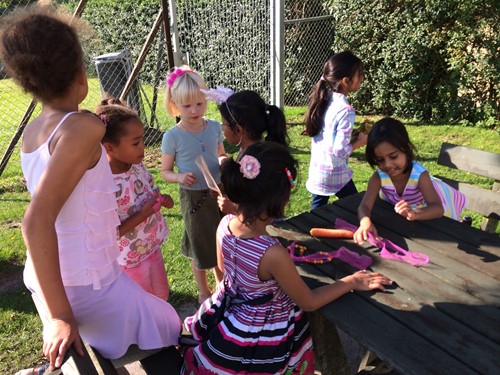
Investments in refugees’ human capital could be financed by the Danish economy which according to the government’s latest statement has a margin for manoeuvrability of around 5 billion Danish kroner. The state's total surplus is expected to total almost 29 billion Danish kroner in the period from 2020 to 2025. These investments will then be paid back socioeconomically in the form of higher employment rates for refugees.
Thirdly, the quality of employment efforts vis-à-vis female refugees must be significantly improved. Municipalities send female refugees to companies for work experience half the number of times as is the case for male refugees. And we know that work placements with companies have a positive effect on employment, not least in relation to private wage subsidy schemes.
Finally, there is a great need for improvement in the quality of the integration effort in relation to the screening and treatment of trauma. Municipal efforts are, among other things, characterized by insufficient screening of trauma symptoms. This results in support that insufficiently meets the needs of traumatized refugee families, coupled by poor knowledge of the target group's resources and needs. The National Audit Office has also provided a very comprehensive critique of the integration efforts that includes trauma. The criticism is that there is insufficient cooperation and coordination surrounding the detection and treatment of traumatized refugees, including because relevant information on the health of refugees is poorly communicated when responsibilities are transferred from the asylum centres to the municipality.
A more general recommendation would be to highlight the great progress that Danish society has made in the area of integration, with the aim of investing much more in refugee integration in the future.
References:
Andersen, J. G. (2008). Holdninger til uddannelse og arbejde blandt unge indvandrere, danskere og deres forældre. Arbejdspapir 20. Rockwool Fondens Forskningsenhed. Odense: Syddansk Universitetsforlag.
Danmarks Statistik (2010). Flest får job gennem netværk i byggebranchen. Nyt fra Danmarks Statistik, nr. 90, den 3. marts 2010.
LG Insigtht (2013). Traumeundersøgelse. Undersøgelse af indsatsen for flygtninge med traumer i Danmark. Odense: LG Insight.
Ministeriet for Flygtninge, Indvandrere og Integration (2010). Tal og fakta om integration. Befolkning, uddannelse, beskæftigelse. Tema om børn. Kbh.: Ministeriet for Flygtninge, Indvandrere og Integration.
Væksthusets Forskningscenter (2019). Somaliske kvinders fortællinger om arbejde og ledighed. Kbh.: Væksthusets Forskningscenter.


